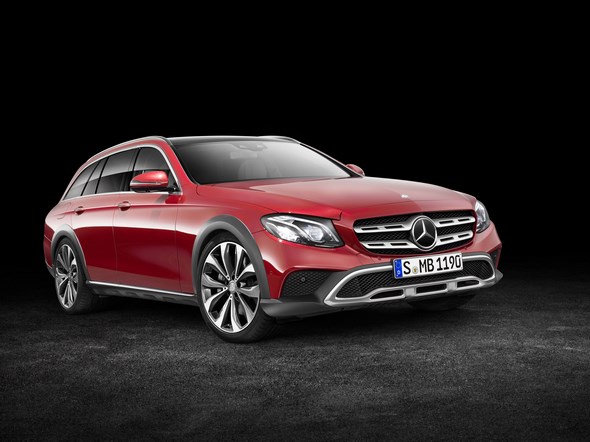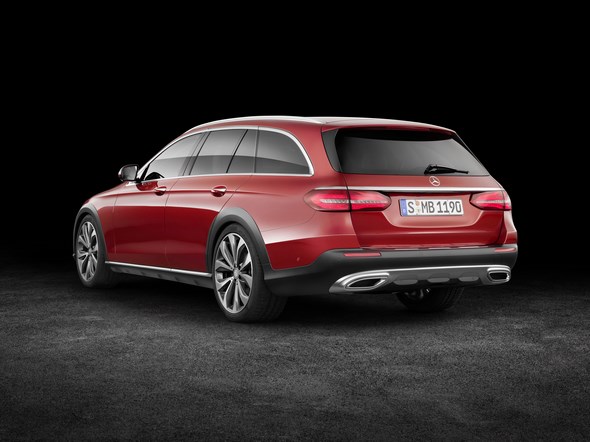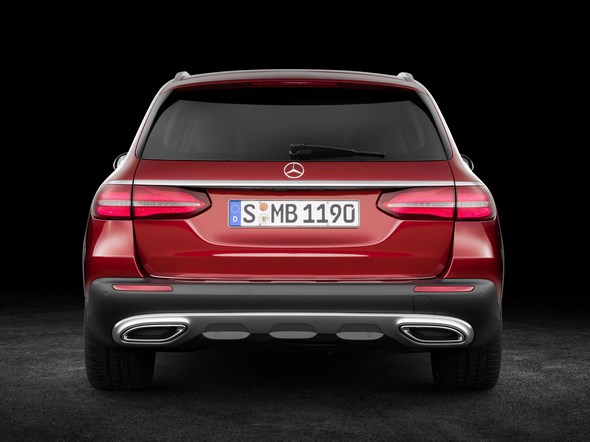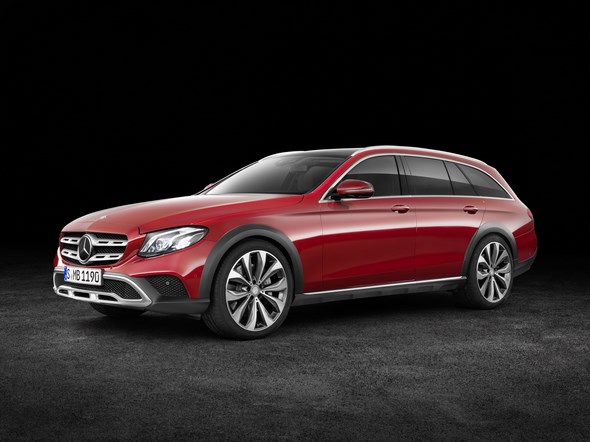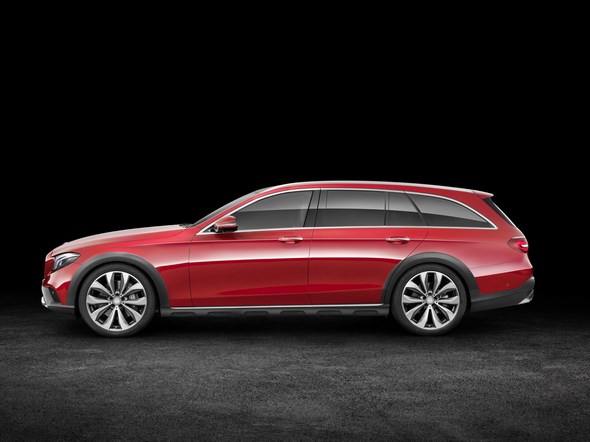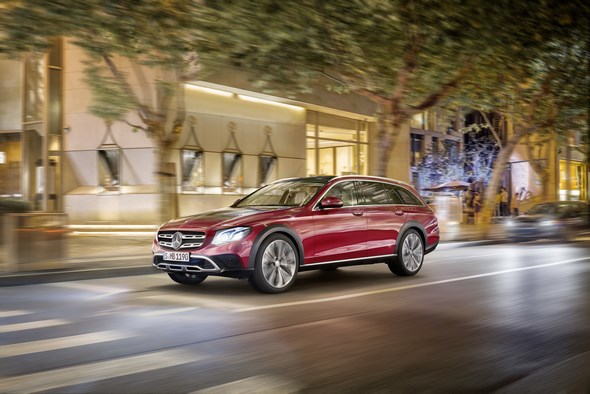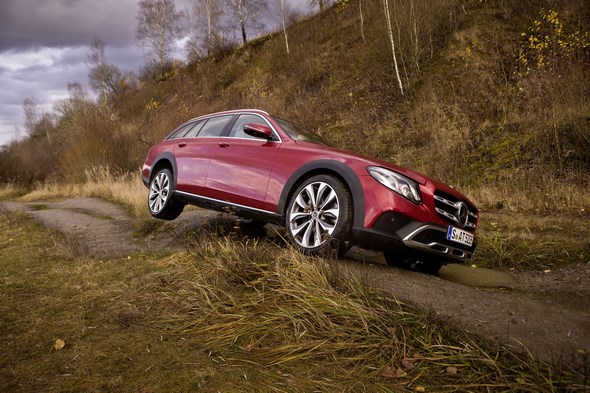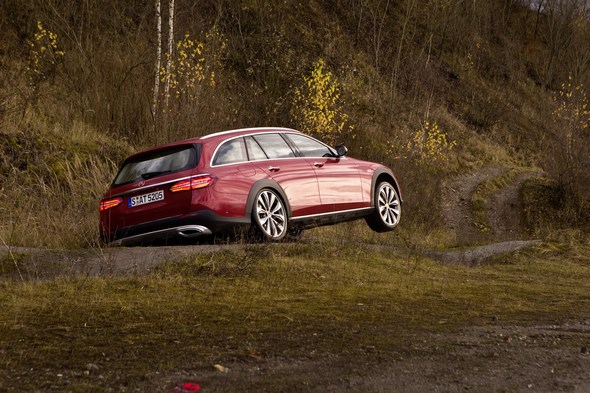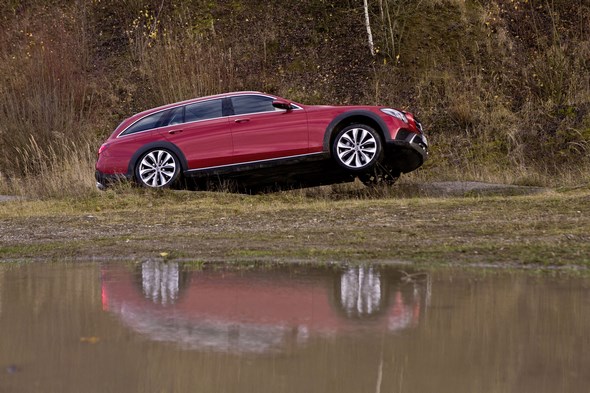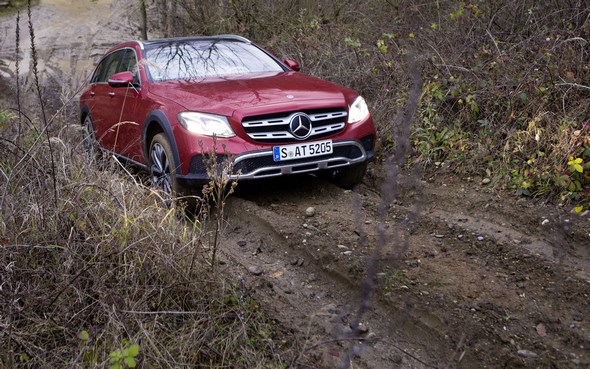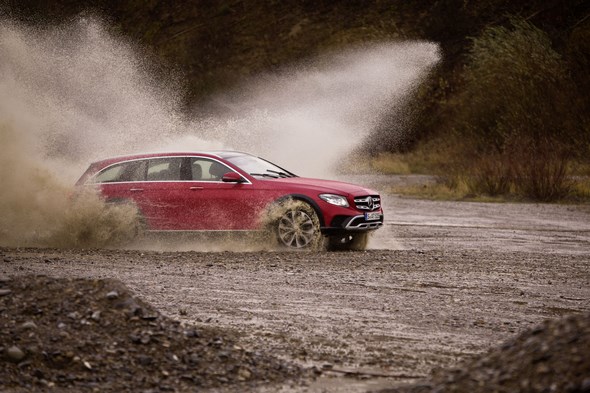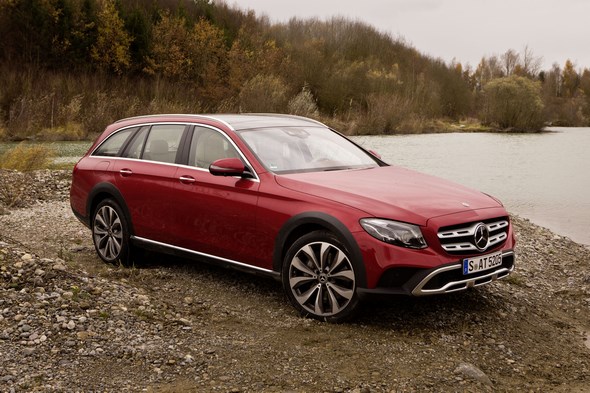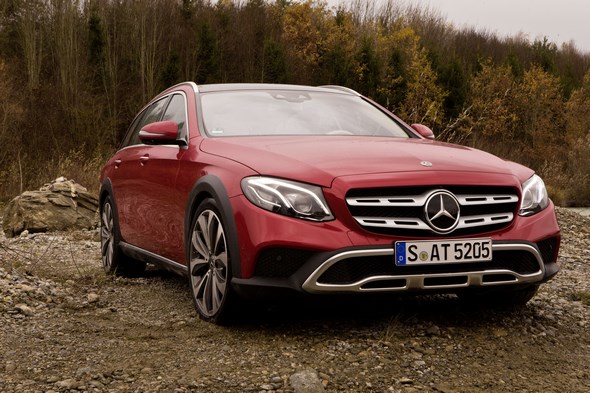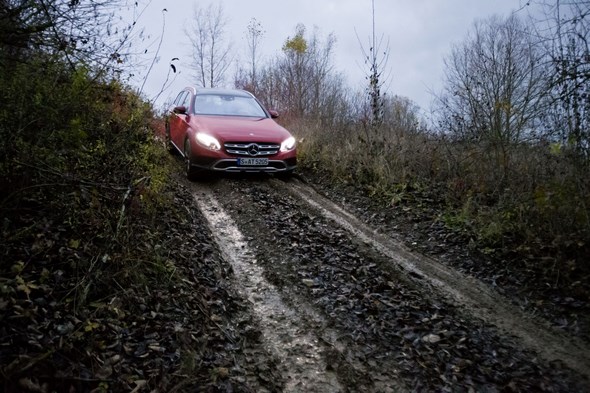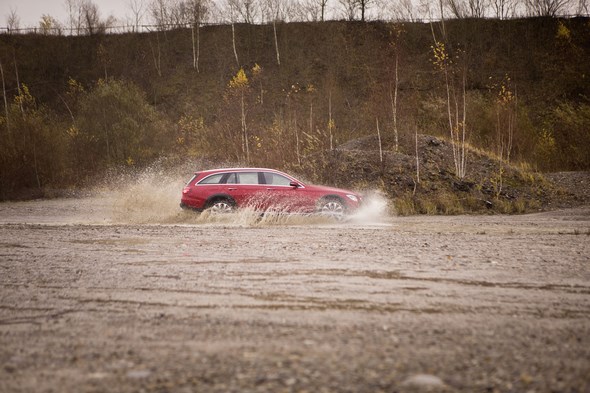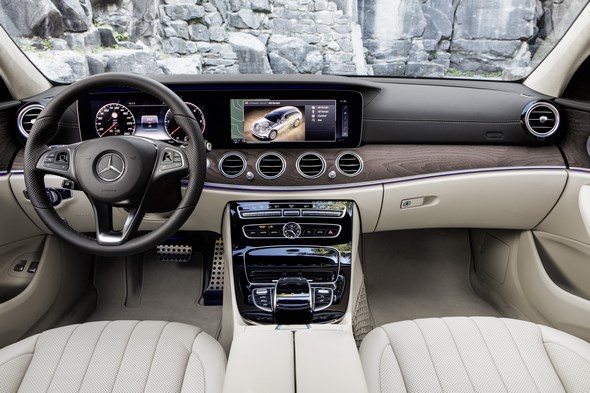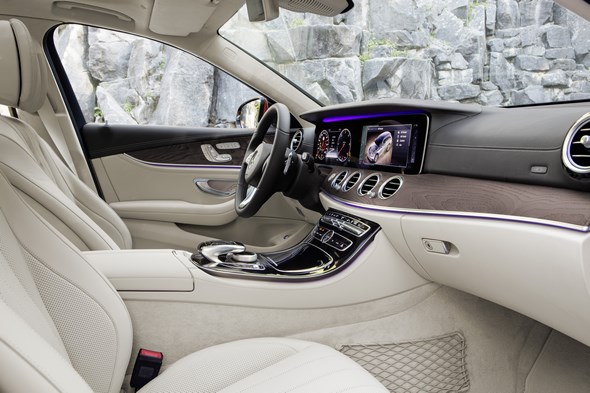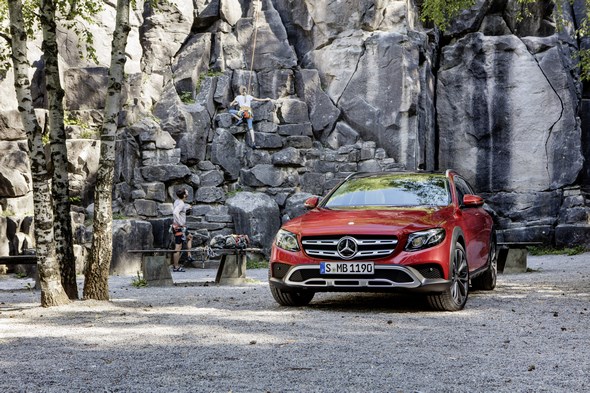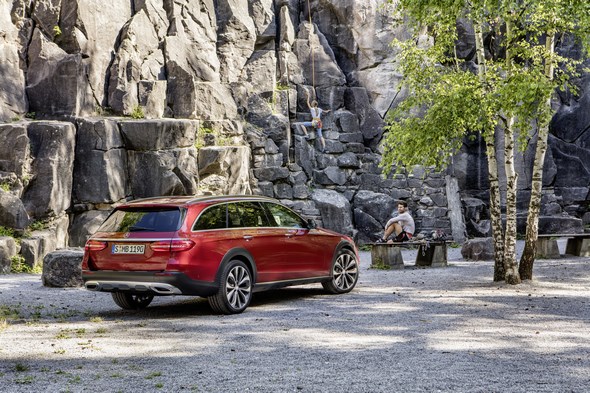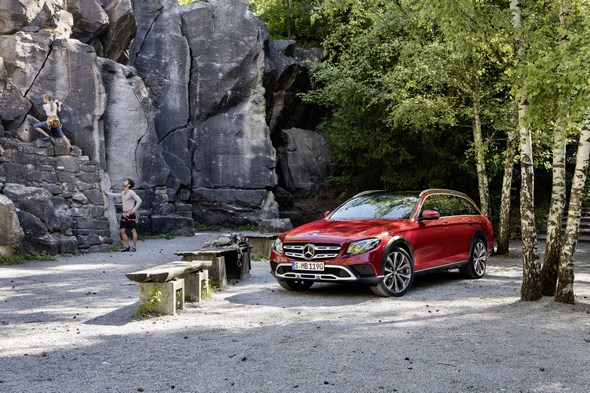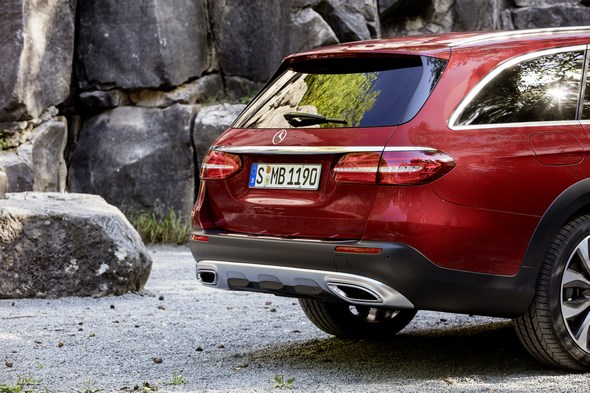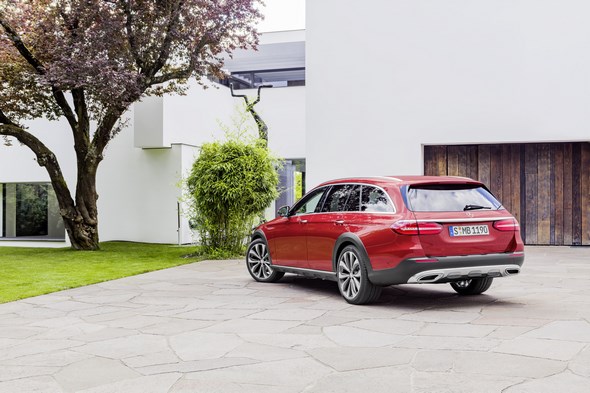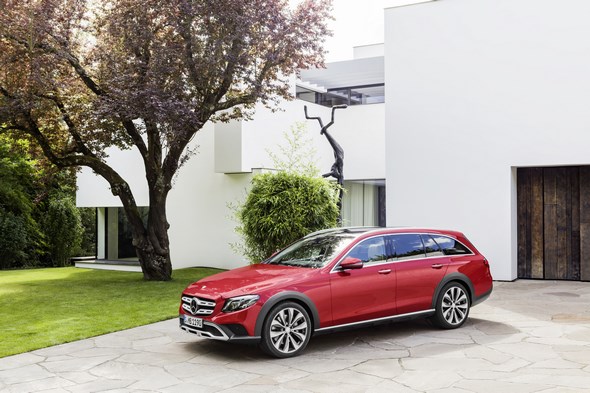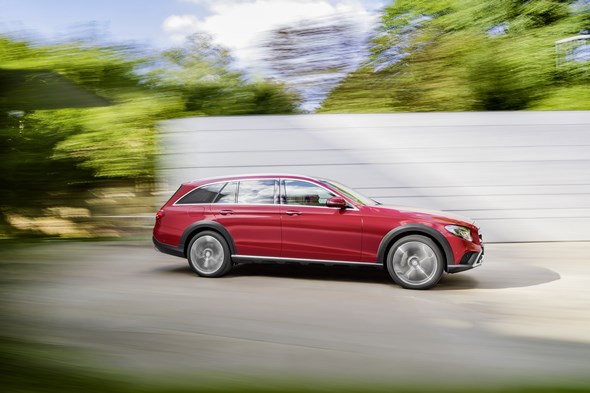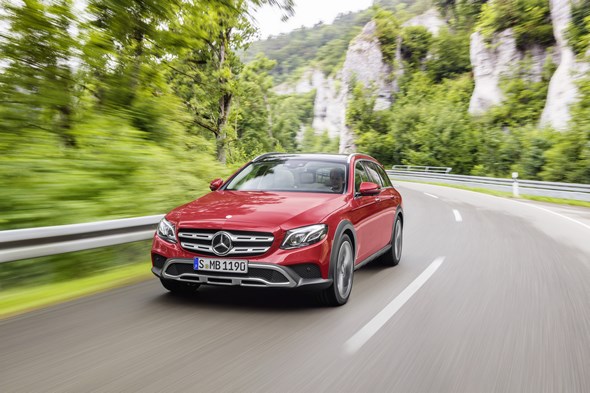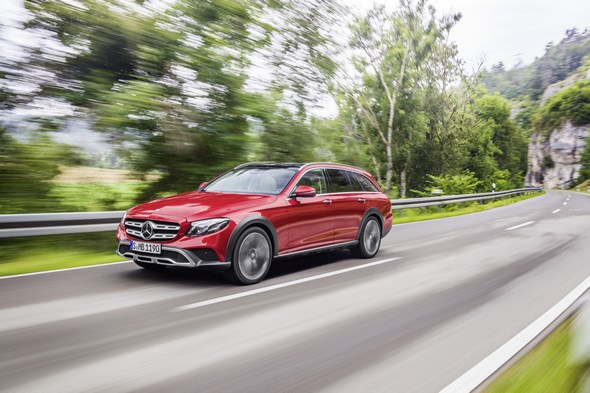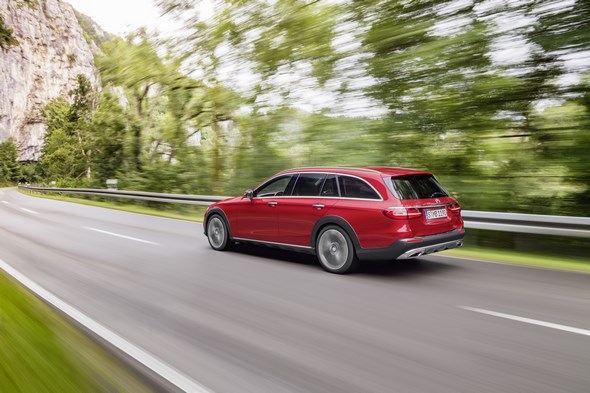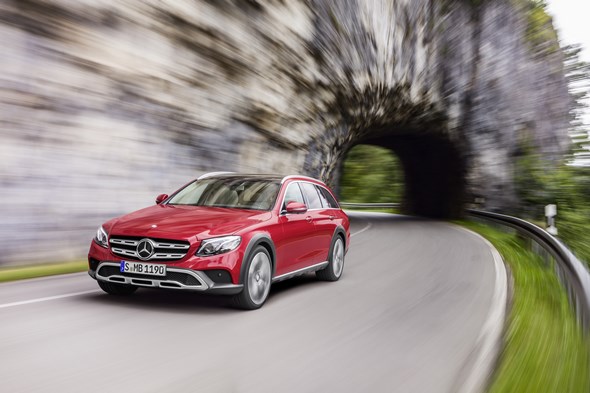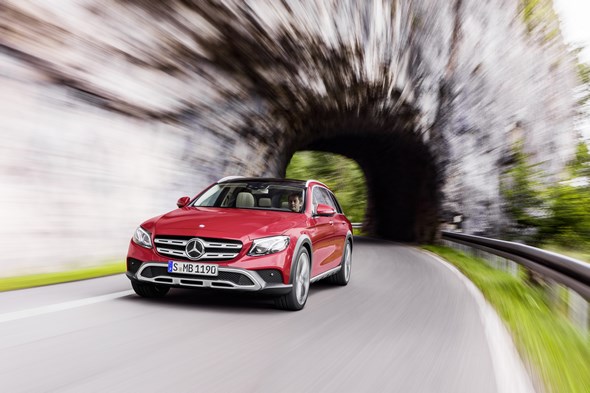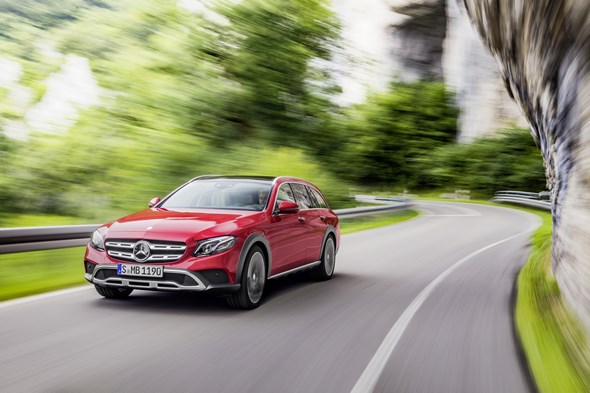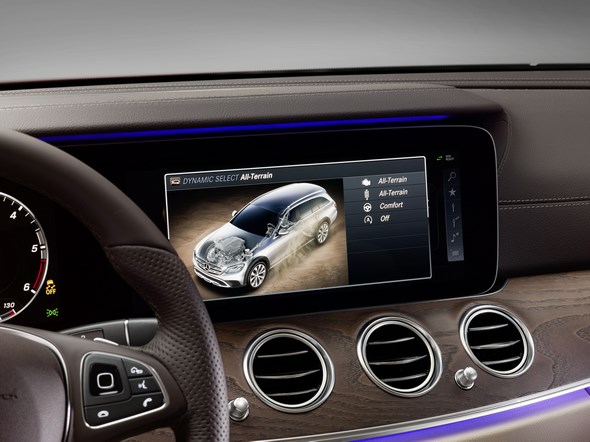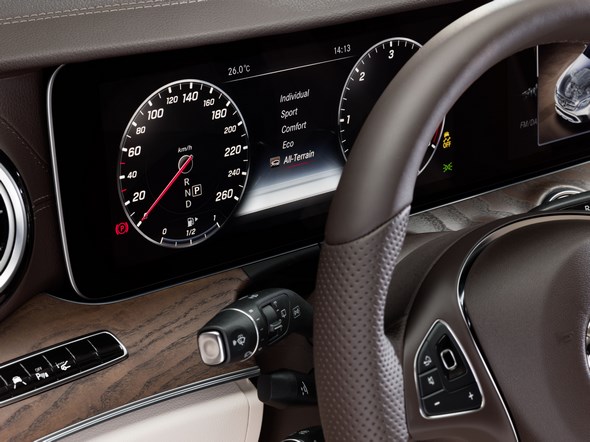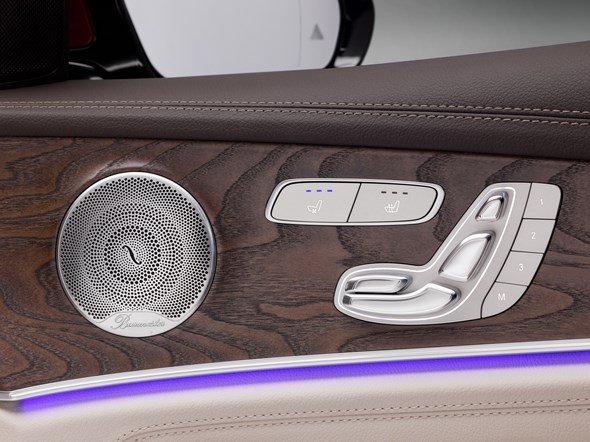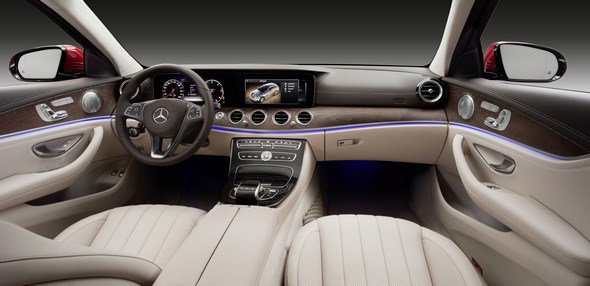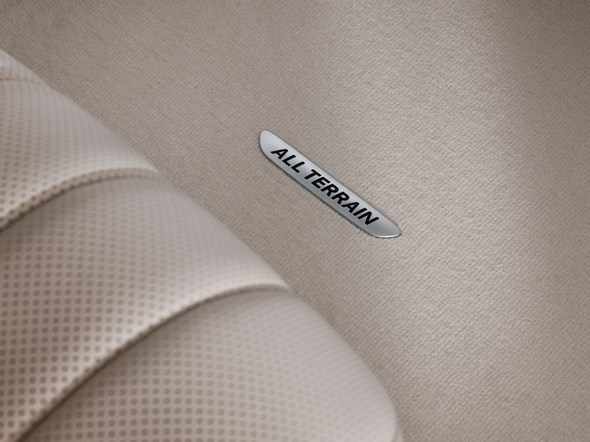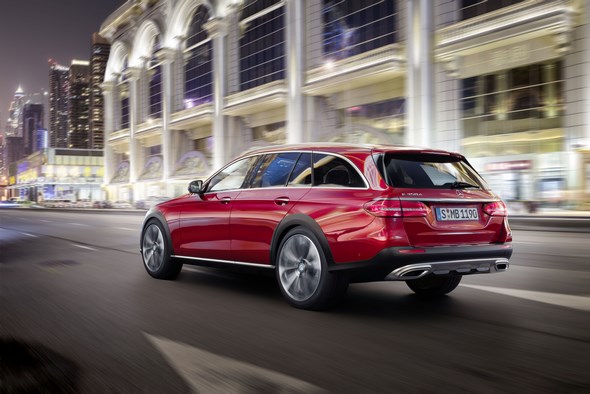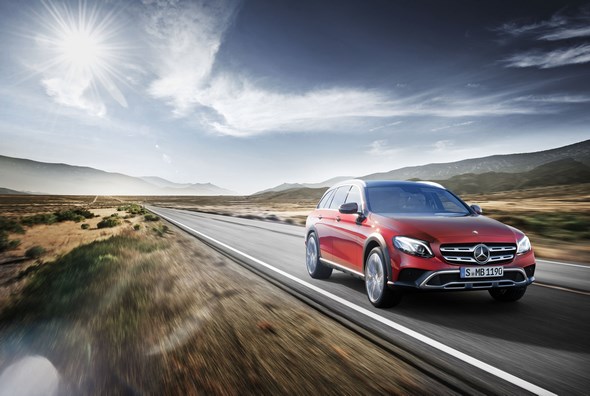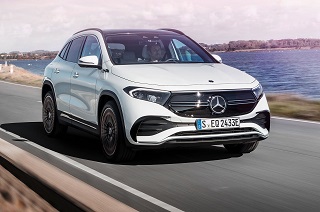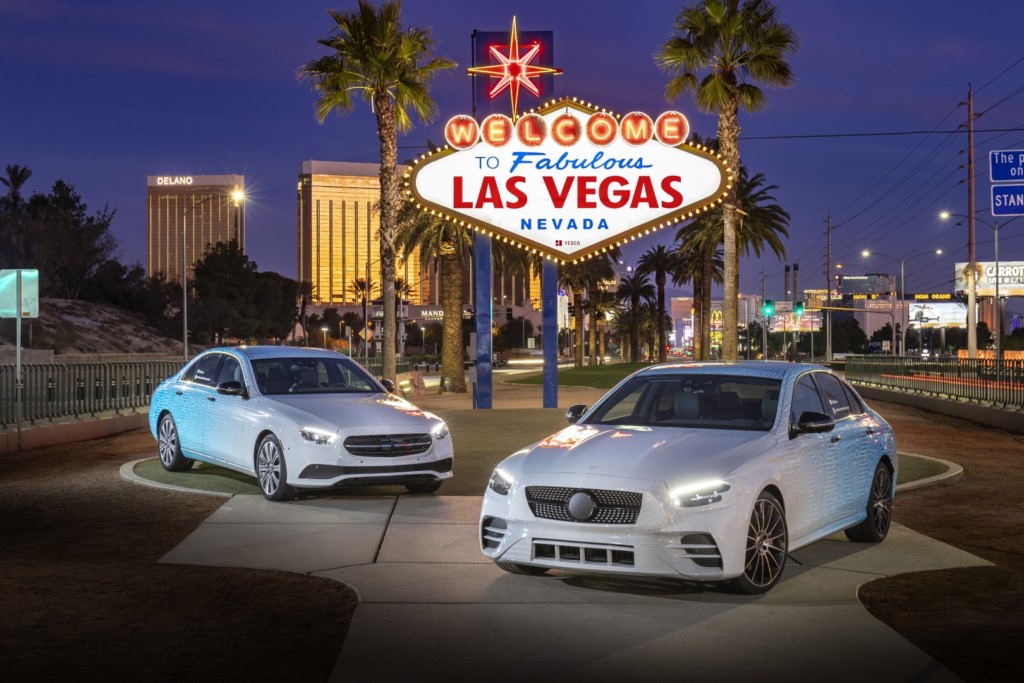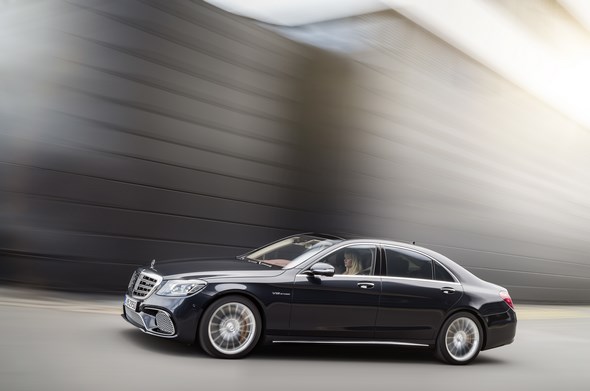New Mercedes-Benz E-Class All-Terrain


Stuttgart. From unpaved tracks to rock climbing or steep serpentine roads to a snow-bound ski lodge – the new E-Class All-Terrain takes routes where conventional estates often have to give up effortlessly in its stride thanks to greater ground clearance with large wheels and 4MATIC all-wheel drive as a standard feature.
And it also cuts a fine figure thanks to its striking look with powerful flared wheel arches and SUV radiator grille. The market launch will follow in the spring of 2017.
“No E-Class has ever been as versatile as the All-Terrain. The new model combines a striking look in SUV style with the intelligent space concept of the estate.
This is coupled with lots of innovative safety features and the multi-award-winning E-Class interior”, says Ola Källenius, Member of the Daimler management board responsible for Sales and Marketing of Mercedes-Benz Cars.
“With 4MATIC allwheel drive as a standard feature and increased ground clearance thanks to the AIR BODY CONTROL multi-chamber air suspension the All-Terrain is a flexible allrounder – for unpaved roads, family and leisure time.”
Thanks to styling elements with an off-road look, such as the twin-louvre grille featuring an SUV style or the black wheel arch covers, the All-Terrain has a powerful and robust appearance which also distinguishes it from the classic estate. Dynamism and modern luxury unite with superiority that leaves no doubt as to the status of this model and follow the current design idiom.
The new model features all of the intelligent luggage space solutions of the E-Class Estate, for example the standard-fit cargo position of the rear seat backrests: it is now possible to position the backrest at an approximately 10-degree steeper angle. This creates an additional 30 litres of cargo volume – making a total of 670 litres – while still allowing full use to be made of the five seats.
In addition, the rear seat backrest folds down in a 40:20:40 split as standard, opening up plenty of potential configurations between transport capacity and seats. To release the backrests, there are electric switches located in the luggage compartment and to the right and left next to the backrests. All E-Class innovations relating to safety, comfort and convenience are available.
The All-Terrain will be launched in the guise of the E 220 d 4MATIC
(143 kW/194 hp) with the newly developed four-cylinder diesel engine. A short time later a variant with a six-cylinder diesel engine will follow.
Both models come with the new 9G-TRONIC nine-speed automatic transmission as standard.
Overview of technical data:
E 220 d 4MATIC
Number of cylinders/arrangement 4/in-line
Displacement (cc) 1950
Rated output (kW/hp at rpm) 143/194 at 3800
Rated torque (Nm at rpm) 400 at 1600-2800
Combined NEDC fuel consumption (l/100 km) 5.2
Combined CO2 emissions (g/km) 137
Efficiency class A
Acceleration 0-100 km/h (s) 8.0
Top speed (km/h) 232
All-Terrain transmission mode: equipped for off-road excursions
The All-Terrain has DYNAMIC SELECT as a standard feature. This enables five transmission modes to be selected with different engine, transmission, ESP® and steering characteristics.
A special model-specific feature is the All-Terrain transmission mode, which offers settings for off-road driving and was derived from the GLE. The even more comfortable suspension configuration and the large wheels with higher sidewalls noticeably further increase ride comfort on rough roads compared with the E-Class.
Selecting the All-Terrain transmission mode with the transmission mode switch raises the chassis in conjunction with the standard AIR BODY CONTROL by +20 mm up to a speed of 35 km/h.
The thresholds for ESP®, active yaw control and acceleration skid control (ASR) are adjusted accordingly. The All-Terrain transmission mode has a special indicator in the vehicle display.
Information displayed there includes the steering angle, the vehicle level (position of the air suspension), the angle of slope and the angle of inclination, the accelerator/brake position and a compass.
The E-Class All-Terrain is 29 millimetres higher than the E-Class Estate – 14 mm are ascribed to the tyres with a larger height/width ratio and 15 mm to the normal driving level of the air suspension.
Thanks to air suspension three levels from 0 to +35 mm are possible. Independent of the transmission mode, the highest level can also be selected manually with the level button on the centre console. The ground clearance is 121 to 156 mm, depending on transmission mode and driving speed.
Mercedes-Benz All-Terrain E 220 d
Engine
Number of cylinders/arrangement 4/in-line, 4 valves per cylinder
Displacement cc 1950
Bore x stroke mm 82.0 x 92.3
Rated output kW/hp 143/194 at 3800 rpm
Rated torque Nm 400 at 1600-2800 rpm
Compression ratio 15.5: 1
Mixture formation High-pressure injection
Power transmission
Front axle Four-link front axle, air springs, gas-pressure shock absorbers, stabiliser
Rear axle Five-link independent rear suspension, air springs, gas-pressure shock absorbers, stabiliser
Braking system Internally ventilated front disc brakes, internally ventilated rear disc brakes, electric parking brake, ABS, Brake Assist, ESP®
Steering Electromechanical rack-and-pinion power steering
Wheels 8.0 J x 19
Tyres 245/45 R 19
Dimensions and weights
Wheelbase mm 2939
Track, front/rear mm 1.604/1610
Length mm 4.947
Width mm 1.861
Height mm 1497
Turning circle m 11.90
Boot capacity, max.* l 670**-1820
Kerb weight acc. to EC kg 1.920
Payload kg 670
Gross vehicle weight kg 2590
Tank capacity/of which reserve l 50/7
Performance and fuel consumption
Acceleration 0–100 km/h s 8.0
Top speed km/h 231
NEDC fuel consumption – urban/extra-urban/combined l/100 km 5,6-5,5/
5,1-5,0/
5,3-5,2
CO2 emissions g/km 139-137
*According to VDA measuring method ** When using the standard cargo position of the rear bench seat, otherwise 640 l
Short interview with Michael Kelz, Head of E-Class Development
“With a great deal of know-how from our SUVs”
Michael Kelz is the Head of E-Class Development and as such has also been responsible for the All-Terrain. We spoke with the qualified engineer about the off-road capabilities of the new model, among other features.
Mr Kelz, with the All-Terrain, Mercedes-Benz is now presenting a model variant which has never existed before in the long tradition of the E-Class. Why?
Kelz: Many customers appreciate the freedom of being able to take their vehicle off the beaten track once in a while. The All-Terrain is able to do this while at the same time offering an extremely high level of efficiency when driving on the motorway. A particularly appealing feature is certainly also the more forceful, more striking design.
Off the beaten track – this just means wet fields and tracks, doesn’t it? What is the level off-road capability of the new model?
Of course the All-Terrain does not boast the same off-road capabilities as our SUV models, this isn’t possible from a purely geometric point of view due to aspects such as the angles of approach and departure and overhangs.
Nevertheless, on test drives the model demonstrated to us just how capable it is in off-road terrain. Spontaneous detours into off-road terrain, along farm tracks, and over snow or sand are possible at any time in the All-Terrain – combined with the outstanding ride comfort, dynamism and agility of the E-Class.”
In addition to 4MATIC all-wheel drive, the All-Terrain has AIR BODY CONTROL multi-chamber air suspension fitted as standard. What other elements contribute to its off-road capabilities?
AIR BODY CONTROL adjusts the ground clearance to suit the particular terrain and therefore increases the All-Terrain model’s off-road capabilities decisively.
But the All-Terrain is not simply a higher-riding E-Class. We incorporated a wealth of SUV know-how into its development. This can be seen in the model-specific All-Terrain transmission mode, for example, for which we altered the thresholds for ESP®, active yaw control and acceleration skid control (ASR) to suit off-road conditions.
With 4MATIC, there was a design change for the new E-Class. The transfer case is now no longer integrated in the automatic transmission, but flange-mounted. What advantages does this solution offer?
Primarily greater efficiency – due to the modified design, we were able to improve efficiency, reduce friction and save around 3 kg in weight. All of the existing advantages of 4MATIC, such as the fast response in difficult road conditions and the compact design, have also been retained.
In addition, with the introduction of multi-stage ESP® in the E-Class, it has also been possible to achieve better control and performance for the all-wheel-drive system in the transmission modes.
Design
Striking look
Thanks to styling elements with an off-road look the All-Terrain has a powerful and robust appearance which also distinguishes it from the classic estate. Dynamism and modern luxury unite with superiority that leaves no doubt as to the status of this model and follow the current design idiom.
The most eye-catching feature of the striking front is the SUV-style twin-louvre grille with a star integrated in the centre. The fins come in iridium silver. The distinctive front bumper and the panelling in underride guard-look, electroplated in silver-chrome, also contribute to the robust appearance. The top part of the three-part front bumper is painted in the body colour and the lower part comes in grained black plastic.
In the side view the black wheel arch covers are a distinctive feature that emphasise the all-terrain character. This also applies to the side skirt that comes in the same colour and features a chrome trip strip. Three exclusive light-alloy wheel sets in 19- and 20-inch format with higher sidewalls give the vehicle a confident look, more ground clearance and enhanced comfort on rough roads.
The All-Terrain also features a model-specific three-part bumper at the rear with the top part painted in the body colour and the lower part in grained black plastic. Further features typical of an SUV include robust outer load sill protection and a visual underride guard electroplated in silver-chrome.
The special features of the interior include a trim element in an aluminium-carbon-fibre look exclusive to the All-Terrain, stainless steel sports pedals with rubber studs and also floor mats with All-Terrain lettering. The equipment of the All-Terrain is based on the AVANTGARDE interior line, EXCLUSIVE and designo appointments are optionally available.
Engine and transmission
A host of innovations to boost efficiency
The All-Terrain will be launched in the guise of the E 220 d 4MATIC
(143 kW/194 hp) with the newly developed four-cylinder diesel engine.
A short time later a variant with a six-cylinder diesel engine will follow. Both models come with the new 9G-TRONIC nine-speed automatic transmission as standard.
The new four-cylinder diesel engine marks the launch of a new engine family at Mercedes-Benz and achieves new levels of efficiency. It is the first passenger car diesel engine to use the stepped-bowl combustion process – named after the shape of the combustion bowl in the piston. The innovations also include the combination of aluminium engine block and steel pistons as well as the further-improved NANOSLIDE® coating of the cylinder walls.
The diesel engine in the All-Terrain E 220 d 4MATIC generates 143 kW (194 hp) and consumes an average of just 5.2 litres per 100 kilometres in the combined NEDC cycle. This is equivalent to CO2 emissions of 137 grams per kilometre. Alongside optimised airflow on the intake and exhaust sides and the use of fourth-generation common-rail injection with pressures up to 2050 bar, the high level of efficiency is due to a reduction in internal friction by around 25 percent.
All the components of relevance for efficient emissions reduction are installed directly on the engine. Supported by insulation measures and improved catalyst coatings, there is no need for engine temperature management during cold starting or at low load. In addition to the advantages in terms of emissions, this results in fuel savings, especially on short journeys. Thanks to the near-engine configuration, exhaust aftertreatment has a low heat loss and optimal operating conditions.
The engine is equipped with multi-way exhaust gas recirculation (EGR). It combines cooled high-pressure and low-pressure EGR. This makes it possible to significantly further reduce the untreated emissions from the engine across the entire engine map, with the centre of combustion being optimised for fuel economy.
The All-Terrain features the 9G-TRONIC nine-speed automatic transmission as standard. Its broad spread (9.15) of gears one to nine allows an overall reduction in engine speed a key factor for high energy efficiency and ride quality. Shortened shift and response times ensure optimum spontaneity combined with very smooth gear changes. This is combined with the transmission’s high efficiency, which is a noticeable advantage in terms of fuel consumption.
Under the microscope: 4MATIC
Enhanced traction, greater driving stability
Whether on rough tracks, muddy dirt roads or ice-covered highways – the E-Class All-Terrain is able to cope with any type of surface effortlessly thanks to the permanent all-wheel drive 4MATIC. 4MATIC is based on the electronic traction system 4ETS in conjunction with the Electronic Stability Program ESP®. 4ETS distributes the power between the front and rear axle in the ratio of 45:55 (details apply to left-hand-drive vehicle).
If one or more wheels lose grip, 4ETS brakes them at lightning speed and automatically diverts the drive power to the wheels offering good traction.
Greater traction and driving stability on slippery surfaces are the key advantages of the all-wheel drive system 4MATIC. With the 4MATIC models of the new E-Class, a design change has taken place: the single-stage transfer case is no longer integrated in the automatic transmission, but is flange-mounted on the 9GTRONIC as a separate system.
This improves efficiency, reduces friction and saves around 3 kg in weight compared with the previous design. On top of this there is optimum matching of the lubricant properties and avoidance of impurities caused by wear from the transfer case in the 9G-TRONIC thanks to separate oil and hydraulic circuits.
Features which have been retained include the compact design of the 4MATIC, which results in no restrictions in the interior and luggage compartment, as well as the so-called pre-lock feature.
As part of this, a double-disc clutch achieving a basic locking torque of approximately 50 Nm between the front and rear axle is fitted to the central differential.
The clutch pack is permanently preloaded via a plate spring. In the case of spinning wheels on one of the two axles, friction torque is transmitted to the axle spinning more slowly by relative movement of the discs.
A sustained improvement to traction and directional stability of the vehicle are achieved through this principle of variable torque shift. Particularly in the case of low coefficients of friction between the tyres and the road surface, the traction and stabilising effect of this so-called pre-lock clutch is clearly noticeable.
Under the microscope: AIR BODY CONTROL
All-round self-levelling with a sensitive response
Thanks to the standard-fit AIR BODY CONTROL air suspension, three levels from 0 to +35 mm are possible on the All-Terrain. By selecting the All-Terrain transmission mode via the transmission mode switch, the suspension is raised by +20 mm at speeds up to 35 km/h.
Independent of the transmission mode, the highest level can also be selected manually with the level button on the centre console.
AIR BODY CONTROL is a sophisticated multi-chamber air suspension system: three chambers of different size in the spring struts of the rear axle and two in the spring struts of the front axle make it possible to control, in three stages, how stiffly the suspension reacts.
Moreover, as neither the air spring struts on the front axle nor the free-standing air spring on the rear axle need be responsible for wheel control or, therefore, absorb transverse forces, the passengers can enjoy a soft basic springing that irons out transverse joints in the road, asphalt repairs and other bumps.
A harder spring rate, for example when cornering and braking, effectively reduces body roll.
Furthermore, the highly sensitive and fast-responding AIR BODY CONTROL features all-round self-levelling for excellent ride comfort even with the vehicle loaded.
It controls the ride height automatically depending on the speed and reduces fuel consumption on the motorway, for example, by lowering the vehicle. When driving on rough roads or access roads, the ground clearance can also be increased at the push of a button using the ride height adjustment switch.
The multi-chamber air suspension is supplemented by continuous, electronically controlled DYNAMIC BODY CONTROL adaptive damping on the front and rear axles. The damping at each individual wheel is adjusted fully automatically to suit the current driving situation and the condition of the road – such as in the case of evasive manoeuvres or on rough tracks.
The system therefore delivers good road roar and tyre vibration characteristics, excellent ride comfort, and outstanding driving dynamics.
Under the microscope: DYNAMIC SELECT
Tailor-made vehicle characteristics
The All-Terrain has DYNAMIC SELECT as a standard feature. This enables five transmission modes to be selected with different engine, transmission, ESP® and steering characteristics. A special model-specific feature is the All-Terrain transmission mode, which offers settings for off-road driving and was derived from the GLE.
The DYNAMIC SELECT transmission modes influence the settings of various systems and components, such as the speed-sensitive power assistance for the steering, the shift points of the automatic transmission, the throttle response, the ECO start/stop function and also the suspension.
These transmission modes are available on the All-Terrain:
Comfort
ECO
Sport
All-Terrain
Individual
“Comfort” mode is the most balanced transmission mode with corresponding suspension tuning and a consumption-optimised powertrain set-up. “Comfort” mode is activated after engine start initially – it is therefore the basic mode so to speak.
The “ECO” transmission mode trims the vehicle for low fuel consumption. The driver can access ECO information in the multifunction display in order to adopt a more economical driving style.
“Sport” mode is characterised by agility and driving pleasure with a sporty tuning and direct accelerator pedal characteristics. The suspension is firm, but still offers good ride comfort.
Selecting the All-Terrain transmission mode raises the chassis in conjunction with the standard AIR BODY CONTROL by +20 mm up to a speed of 35 km/h. The thresholds for ESP®, active yaw control and acceleration skid control (ASR) are adjusted accordingly.
The All-Terrain transmission mode has a special indicator in the vehicle display. Information displayed there includes the steering angle, the vehicle level (position of the air suspension), the angle of slope and the angle of inclination, the accelerator/brake position and a compass.
The “Individual” transmission mode additionally offers the possibility to vary individual parameters for suspension, steering and powertrain.
Assistance and safety systems
Intelligent Drive next Level
As the most intelligent executive saloon, the new E-Class sets new benchmarks in terms of safety, comfort and reducing the driver’s workload. These innovations are, of course, also available on the Estate and the AllTerrain.
The engineers at Mercedes-Benz achieve the ideal combination of safety, comfort and stress relief by constantly further developing the safety components and driving assistance systems. Integral Safety and Intelligent Drive are becoming increasingly intertwined, working in synergy in a cross-system concept.
Its components can: assist and provide stress relief during normal driving detect dangers warn, assist and, if necessary, intervene in a timely manner consequently prevent accidents or reduce the severity of accidents activate protective measures such as the PRE-SAFE® components as a precaution in the event of danger and thus provide on-demand protection
The individual functions are linked to networked sensors and, therefore, a wealth of information about the vehicle and its surroundings – including an enhanced multi-purpose stereo camera behind the windscreen and new multi-stage radar sensors with adjustable range and opening angle around the vehicle plus tried-and-tested sensors such as ultrasonic sensors and the 360° camera.
The combined use of data from the sensors allows analysis of complex traffic situations, better detection of potential dangers on the road and, therefore, the ability to further enhance the capabilities of the safety and assistance systems.
To be able to offer optimal assistance also in wintry conditions, the latest-generation front radar is fitted with so-called Radom heating, which effectively prevents the sensor being interfered with by snow.
Extensive assistance systems already as standard
Active Brake Assist is fitted as standard. This further advanced system can provide effective aid in mitigating the severity of rear-end collisions or even in preventing them entirely.
To this end, the radar-based system constantly monitors the area of traffic in front of the vehicle, and can determine the distance and speed of the vehicles ahead.
If the following distance drops significantly below the safety threshold at speeds above 30 km/h, the system gives the driver a visual warning.
If, in the speed range between 7 and 250 km/h, it detects an acute risk of collision because of slower or stopped vehicles or, in the speed range between 7 and 80 km/h, because of stationary vehicles or crossing pedestrians, the system gives the driver an additional audible warning.
It also computes the brake pressure required to prevent a collision, if this is still possible. If, having been warned, the driver then steps on the brake pedal, the system is capable of boosting insufficient braking pressure in line with the needs of the situation. In so doing, it makes the best possible use of the remaining distance in order to leave the vehicles behind room to brake.
If the driver fails to respond, Active Brake Assist can go one step further and, if the danger of collision persists, can perform autonomous braking for slower moving and stopping vehicles at speeds of up to 200 km/h to mitigate the severity of the accident and ideally prevent the collision entirely.
The system also brakes if stationary vehicles or crossing pedestrians are detected up to a speed of around 60 km/h, and can prevent collisions up to 50 km/h, depending on the situation.
ATTENTION ASSIST with adjustable sensitivity, which can warn the driver in timely manner of inattentiveness and drowsiness, is also included as standard. Crosswind Assist supports the driver by helping to considerably counteract disturbances such as strong gusts of wind by means of one-sided braking via ESP®.
DRIVE PILOT: Intelligent Drive next Level in the Driving Assistance package
The All-Terrain optionally offers additional assistance systems, the key innovations of which have been combined in a new Driving Assistance package.
The most important functions include semi-autonomous driving on motorways, country roads and even in the city as well as assistance when changing lanes on multi-lane roads, for example when overtaking. Furthermore, the assistance systems are capable in more and more situations of autonomously braking the vehicle if required and providing active assistance during evasive manoeuvres.
The centrepiece of the Driving Assistance package is DRIVE PILOT. This assistance system, as Distance Pilot DISTRONIC, automatically maintains the correct distance to vehicles in front by adjusting the car’s higher desired speed to that of a slower-moving vehicle ahead before accelerating back up to the desired speed once the way ahead is clear again.
With its Steering Pilot subfunction, it can also keep the EClass in lane up to speeds of 210 km/h. This can make life easier for the driver, who no longer needs to operate the brake or accelerator pedal during normal driving and also receives plenty of steering assistance – even on bends.
For orientation, DRIVE PILOT uses an enhanced multi-purpose stereo camera behind the windscreen and new radar sensors beneath the radiator grille and the rear bumper to detect road markings, the vehicle in front and also its surroundings.
Consequently, at speeds up to 130 km/h, it is not dependent on clearly visible lane markings as it can continue to intervene actively, like in a swarm, if the lines on the road are unclear, e.g. at roadworks, or even if there are no lines on the road at all.
If COMAND Online is fitted, DRIVE PILOT can provide enhanced comfort through the selectable Speed Limit Pilot subfunction. By means of Distance Pilot DISTRONIC, it can autonomously adjust the vehicle’s speed in response to camera-detected speed limits, including gantries and signs at roadworks, or speed limits logged in the navigation system, such as 50 km/h in built-up areas or 100 km/h on country roads.
Despite active longitudinal and transverse guidance with enhanced steering assistance, DRIVE PILOT continues to be designed as a semi-automated assistance system in which the driver needs to keep their hands on the steering wheel.
On the one hand, this is a technical necessity, while, on the other, it is a legal requirement. Intelligent hands-on detection provides a noticeably increased customer benefit while taking account of, for example, vehicle speed or road type and curvature.
This can take the pressure off the driver and provide assistance, especially in bumper-to-bumper or congested traffic, yet also on long journeys.
A contribution is also made by the intelligent and navigation-based design of the automatic restart after automatic stopping in stop-and-go traffic and traffic jams, such as on motorways up to 30 seconds.
Active Emergency Stop Assist can brake the vehicle to a standstill in its lane if it detects that the driver is permanently not taking control while on the move. If there is no steering wheel movement over a longer period when the Steering Pilot is active, the system gives the driver a visual and audible prompt to place his/her hands on the wheel.
If, after being repeatedly warned, the driver does not react by steering, accelerating, braking or pressing a Touch Control element, the vehicle safely decelerates to a standstill in its lane and warns the traffic behind using the hazard warning flashers.
Lane-changing made easy
Special DRIVE PILOT innovations include an Active Lane-change Assistant, which assists the driver when changing lanes, e.g. when overtaking on multi-lane roads.
Once the driver has indicated to turn for at least two seconds, the Active Lane-change Assistant helps with steering the vehicle into the desired adjacent lane if it detects that the lane is unoccupied.
The driver merely monitors the change of lane. It is irrelevant whether the driver wants to move to the right-hand lane or change to the left lane for overtaking.
This is made possible by means of a long-range radar and the stereo camera which monitor the area in front of the vehicle. Multi-mode radars continually check the area towards the rear and to the side.
The criteria for operation of Active Lane Change Assist are:
operation of the turn indicator for longer than two seconds
the unoccupied zone detection system allows a lane change within three seconds
Steering Pilot is activated
vehicle travelling on a multi-lane, motorway-like road, detected via the navigation module integrated into COMAND Online
speed between 80 and 180 km/h
Active lane change is aborted by the system if the sensor system detects an obstacle, no longer sees lane markings, the driver countersteers or Steering Pilot is switched off.
Automatic braking in an emergency
Further assistance is provided by an Active Brake Assist with a significantly extended functionality compared with the standard basic functions. Its job is to warn the driver of imminent collisions, to optimally assist them during emergency braking and, if necessary, also to initiate autonomous braking.
Mercedes-Benz’s objective is thus to prevent collisions or at least to reduce their consequences.
Active Brake Assist likewise uses the radar sensors installed in the vehicle as well as the multi-purpose stereo camera. These enable it to detect whether the vehicle in front is slowing down, stopping or is stationary.
If the system detects a risk of collision and the driver fails to respond to a collision warning or is late responding, the system automatically initiates autonomous braking.
The cross-traffic function of Active Brake Assist also detects cross-traffic and pedestrians in the danger area in front of the vehicle. Also in these cases, Active Brake Assist first warns the driver if there is a risk of collision, providing assistance if the driver fails to brake hard enough.
If the driver fails to react, the system initiates braking automatically. If a pedestrian enters the danger area relatively late, the assistance system brakes simultaneously with the warning to allow the speed of the vehicle to be reduced faster.
Active Brake Assist is active in a speed range from 7 to 250 km/h for moving vehicles and can react to stationary vehicles between 7 and 100 km/h. Under ideal conditions, it can thus prevent a collision with a stationary vehicle up to around 70 km/h and a collision with pedestrians up to a speed of around 65 km/h.
In end-of-tailback scenarios with no opportunity for evasive action, Active Brake Assist can automatically intervene even up to 130 km/h and, ideally, entirely prevent such especially dangerous rear-end collisions up to 100 km/h.
Depending on the situation, the cross-traffic function is capable of preventing collisions with crossing traffic in a speed range up to around 70 km/h or reducing the severity of the collision. The system thus generally makes a significant contribution to preventing accidents or reducing their severity.
Safe evasive action
Highlights of the Driving Assistance package include Evasive Steering Assist. This can help the driver to avoid a pedestrian detected by the assistance system using the radar sensors and multi-purpose stereo camera.
If the driver initiates an evasive manoeuvre by turning the steering wheel, the system provides assistance by adding precisely calculated steering torque to support the movement of the steering wheel.
This torque helps the driver to avoid the pedestrian in a controlled manner and then makes it easier to straighten the vehicle up again so that it can drive past safely. While the philosophy behind Evasive Steering Assist is to provide the driver with significant assistance, the initiative to take evasive action must come from the driver.
This is because, if evasive action were automatic, a previously inattentive driver might be so surprised by the spontaneous movement of the steering wheel that they might react incorrectly and, for example, attempt intuitively to steer in the opposite direction.
Proven assistance systems
The intelligent assistance systems in the new Driving Assistance package also include, for example, proven systems that have been further developed in terms of their mode of operation and the sensors they use.
Active Lane Keeping Assist can help stop the driver from unintentionally changing lane, this being done by corrective one-sided application of the brakes in the case of solid or broken lines and risk of collision, e.g. with oncoming traffic or fast overtaking vehicles.
Active Blind Spot Assist can now also warn of the risk of a lateral collision in typical urban traffic at low speeds and, in addition, as before, correctively intervene at the last moment to prevent a lateral collision, e.g. with cyclists, at speeds above 30 km/h and activate the PRE-SAFE® belt tensioners.
PRE-SAFE® PLUS can protect against collisions with following traffic and their impacts on the occupants by warning the vehicle behind, activating the PRE-SAFE® belt tensioners and, if stationary, by applying the brakes to stop the vehicle from being shunted.
Infotainment
Very well entertained and connected
In the E-Class, Mercedes-Benz has debuted an all-new COMAND Online generation. One of many highlights is the wireless integration of smartphones.
Mercedes-Benz has ushered in a new era of digitalisation and networking in the E-Class. This includes effortless integration of the smartphone into the vehicle’s infotainment system by means of capacitive aerial coupling and wireless charging.
This means that mobile phones can be charged wirelessly and at the same time connected to the vehicle’s exterior aerial. This dispenses with the need to find a plug and connect a cable.
Simply place the device on the charging pad at the front of the centre console and touch the “NFC” logo to connect the smartphone with the multimedia system via Near Field Communication (NFC). The inductive charging pad measures 153 x 90 millimetres and is suitable for mobile devices that either support the Qi standard or can be upgraded to this standard.
Phone calls can then be made via the Bluetooth® hands-free system. There is another advantage: using Near Field Communication, the customer’s smartphone becomes the digital vehicle key with which the car can be locked and unlocked as well as started.
If the vehicle is equipped with COMAND Online, it is also possible to use Apple’s smartphone-based infotainment system CarPlay® as well as Google’s Android Auto™. If a corresponding smartphone is connected by USB, the customer can, if desired, switch to the CarPlay® or Android Auto interface.
Free web browsing is possible when the vehicle is stationary thanks to the integrated SIM card in the communications module. With COMAND Online, Mercedes-Benz apps can also be used while driving.
Internet and diverse data sources: even for the base version
In addition to COMAND Online, the Audio 20 USB/GPS infotainment systems with online capability are available. Like COMAND Online, they are equipped with a Bluetooth® hands-free system.
Audio and video playback is possible from various sources with all three variants. For example via Bluetooth® or USB stick. COMAND Online also offers integrated hotspot functionality. It allows passengers in all seats to connect different WiFi-capable devices, such as laptop or tablet computers, to the internet.
Navigation: photo-realistic building display
The Audio 20 GPS offers entry-level navigation on an SD card. It can be optionally supplemented with the Garmin® MAP PILOT navigation system.
COMAND Online offers fast 3D hard-drive navigation with topographical map display, photo-realistic 3D buildings and 3D map rotations. The system presents its content interactively and includes features such as an animated compass.
Live Traffic Information: the very latest traffic data
For the first time, comprehensive information is displayed on the navigation map: in addition to volume of traffic in real time, for example, also Car-to-X warning messages, the weather, filling stations including current fuel prices on the E 220 d All-Terrain and vacant parking spaces.
Whereas the familiar Live Traffic Information was previously reserved for COMAND Online, the E-Class even offers this function with the Audio 20 GPS with Garmin® MAP PILOT system.
Live Traffic Information allows the reception of up-to-the-minute and accurate traffic information, which is updated by the system every two minutes on the Garmin® MAP PILOT system or COMAND Online.
Taking the current vehicle location into account when requesting traffic information also ensures that the enquiring vehicles receive all the traffic information of relevance to them.
The received traffic information is based on so-called “Floating Car Data” the key technology for precise acquisition of traffic data.
Concierge service: personal support
Even the Mercedes me connect Standard Services make life for Mercedes-Benz drivers easier all-round – for example, vehicle diagnostics in the event of a break down or an accident.
The optional Remote Online Services allow drivers to connect to their vehicle from anywhere and at any time, to access vehicle information and to remotely activate a variety of functions.
The range of functions includes Vehicle Tracker, Remote Door Locking and Unlocking, and Programming of Auxiliary Heating. This works both with the Mercedes me app (available for iOS and Android) and via the Mercedes me Portal (www.mercedes.me).
And the new Concierge Service gives participating customers a wealth of personalised assistance, from making a restaurant reservation to obtaining tips about tourist routes, information on cultural and sporting events and bookings through to sending navigation destinations directly to the vehicle.
Gaining access is straightforward: registered Mercedes me connect users can establish a telephone connection with the Concierge Service in a preset language in 19 countries across Europe using either the iCall button in the overhead control panel or the Mercedes me app. The personal assistant takes care of everything else.
Frontbass system: a truly special listening experience
The Frontbass system in the E-Class delivers a special listening experience as standard. It uses the space in the cross member and side member of the body structure as a resonance chamber for the bass speakers.
The standard audio system has an output of 4 x 25 watts and seven speakers. The Burmester® surround sound system is optionally available for superior listening pleasure.
It drives 13 speakers with a 9channel DSP amplifier and delivers a total system power of 640 watts. All the speakers are additionally optimised for performance with the premium sound system.
Under the microscope: Rear Seat Entertainment System
Elegant plug-in solution
In a few simple steps, the rear bench seat in the E-Class becomes a communications centre and a cinema courtesy of iPad® Rear Seat Integration Plug & Play. The system is a joint development of Mercedes-Benz and Mercedes-Benz Accessories GmbH.
A requirement for the plug-in solution for iPad® is the optional extra in the guise of the “preinstallation for entertainment and comfort”, a slot in the backrests of the driver and front passenger seats.
The preinstallation provides a convenient universal connection to the vehicle with integrated power supply for a variety of entertainment and comfort equipment. The system has a quality feel and is firmly closed by means of a flap in the colour of the seat back section. The flap is only unlocked on insertion of a suitable holder.
The holder, which is available as a genuine accessory from Mercedes-Benz sales outlets, can accommodate a variety of accessories, for example the iPad® Rear Seat Integration Plug & Play. This cradle is available for the iPad® 4, Air and Air 2.
Two seconds after inserting the holder, the device is automatically connected to the power supply via sliding contacts (12 V, max. 6 A). The cradle for the iPad® is placed on the holder and locked in place.
After inserting the tablet in the cradle, the iPad® is automatically charged at 2.1 A. The holder has an additional USB port. This enables other devices to be powered, such as smartphones (1.2 A). The holder can be adjusted to the correct viewing angle and rotated through 180 degrees, thus enabling the tablet to be used vertically.
The slot is designed as a universal interface for another accessory, for example a coat hanger, folding table, holder for tablet PC and action cam holder (market launch in March 2017). These meet all statutory safety regulations,a s well as the internal safety regulations of Mercedes-Benz. These include a head impact test pursuant to ECE R 21 as well as other sled crash tests.
The preinstallation for entertainment and comfort and the iPad® Rear Seat Integration Plug & Play are available with immediate effect from Mercedes-Benz sales outlets or online at http://shop.mercedes-benz.com.
Versatility and intelligence in a striking package

